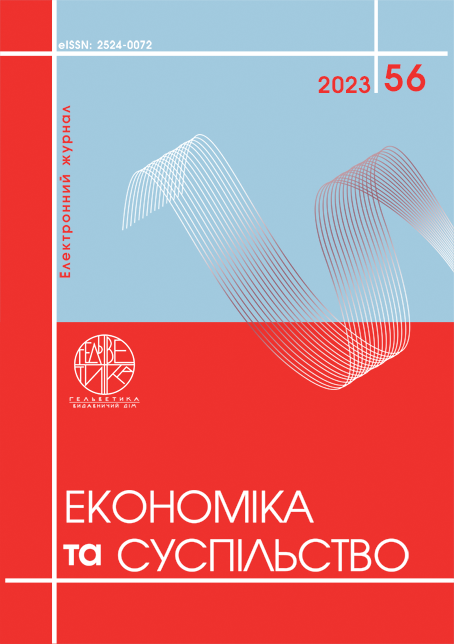DIGITAL FINANCIAL ASSETS MARKET: REGULATION OF RISKS
Abstract
The objective of this article is to explore avenues for improving the state regulation of the digital financial assets market. The author proposes a set of principles essential for formulating a regulatory framework for the digital financial assets market in Ukraine. These principles include: a) recognizing the impracticality of banning the circulation of digital financial assets and especially cryptocurrencies within national markets; b) advocating for comprehensive regulation involving all financial market regulators, fiscal bodies, and financial monitoring entities; c) establishing a specialized process for the conversion of crypto-assets to fiat currencies and vice versa; d) facilitating global data exchange among regulators; e) implementing licensing requirements for services facilitating the exchange of crypto-assets for fiat currencies; g) instituting specific regulations governing operations with digital financial assets conducted by financial intermediaries; h) implementing balanced regulations and taxation for operations involving digital financial assets, considering their global nature and minimizing the risk of transactions by Ukrainian residents moving beyond national borders. The article highlights the adverse impact of cryptocurrencies circulating in "gray" jurisdictions on the efficacy of regulating operations within national financial markets. Market participants often intertwine cryptocurrency transactions with activities conducted through non-public offshore entities. To address this challenge, the author proposes two solutions. Firstly, central banks should expedite the development of their own digital currencies (CBDC). However, the author notes the slow progress in this regard, with only three jurisdictions—namely the Bahamas, Jamaica, and Nigeria—having issued CBDC at the time of the study. While anticipating that the implementation of CBDC will gradually displace loosely regulated cryptocurrencies, the author cautions against their potential negative use, such as evading sanctions. Secondly, the author suggests the need for the FATF to introduce a global procedure for regulating the circulation of cryptocurrencies, establishing unified rules applicable to all countries. Simultaneously pursuing both the development of CBDC and a global regulatory framework through FATF is seen as a strategy to enhance the security of the cryptocurrency market and substantially mitigate national security risks.
References
The 2023 Geography of Cryptocurrency Report. Chainalysis. 2023. 97 р. URL: https://go.chainalysis.com/rs/503-FAP-074/images/The%202023%20
Geography%20of%20Cryptocurrency%20Report.pdf
Cryptocurrency Ownership Data. Тriple-А. URL: https://triple-a.io/crypto-ownership-data/ (дата звернення: 30.09.2023).
Adrian Т., Iyer Т., Qureshi М. Crypto Prices Move More in Sync With Stocks, Posing New Risks. IMFBlog. 2022. January 11. URL: https://www.imf.org/en/Blogs/Articles/2022/01/11/crypto-prices-move-more-in-sync-with-stocks-posing-new-risks (дата звернення: 30.09.2023).
Assessment of Risks to Financial Stability from Crypto-assets. The Financial Stability Board. 2022. 30 р. URL: https://www.fsb.org/wp-content/uploads/P160222.pdf
Updated Guidance for a Risk-Based Approach for Virtual Assets and Virtual Asset Service Providers. FATF. 2021. 111 р. URL: https://www.fatf-gafi.org/content/dam/fatf-gafi/guidance/Updated-Guidance-VA-VASP.pdf.coredownload.inline.pdf
Lin К. Blockchain Mining Power and Market Quality in Cryptocurrency Trading. WFE Working Papers. 2023. №5. 21 р. URL: https://www.world-exchanges.org/storage/app/media/Crypto%20Mining%20and%20Market%20Quality.pdf
Perkins-Southam Т., Pearl D. Best Crypto Rewards Cards. Forbes. 2023. October. URL: https://www.forbes.com/advisor/credit-cards/best/crypto-rewards/
Central Bank Digital Currencies. BIS. 2018. 34 р. URL: https://www.bis.org/cpmi/publ/d174.pdf
Today's Central Bank Digital Currencies Status. CBDC Tracker. URL: https://cbdctracker.org/ (дата звернення: 30.09.2023).
Chainalysis. (2023). The 2023 Geography of Cryptocurrency Report. 97 р. Available at: https://go.chainalysis.com/rs/503-FAP-074/images/The%202023%20
Geography%20of%20Cryptocurrency%20Report.pdf
Triple-A. (n.d.). Cryptocurrency Ownership Data. Available at: https://triple-a.io/crypto-ownership-data/ (accessed: September 30, 2023).
Adrian Т., Iyer Т., Qureshi М. (2022, January 11). Crypto Prices Move More in Sync With Stocks, Posing New Risks. IMFBlog. Available at: https://www.imf.org/en/Blogs/Articles/2022/01/11/crypto-prices-move-more-in-sync-with-stocks-posing-new-risks (accessed: September 30, 2023).
The Financial Stability Board. (2022). Assessment of Risks to Financial Stability from Crypto-assets. 30 р. Available at: https://www.fsb.org/wp-content/uploads/P160222.pdf
FATF. (2021). Updated Guidance for a Risk-Based Approach for Virtual Assets and Virtual Asset Service Providers. 111 р. Available at: https://www.fatf-gafi.org/content/dam/fatf-gafi/guidance/Updated-Guidance-VA-VASP.pdf.coredownload.inline.pdf
Lin К. (2023). Blockchain Mining Power and Market Quality in Cryptocurrency Trading. WFE Working Papers. vol. 5. 21 р. Available at: https://www.world-exchanges.org/storage/app/media/Crypto%20Mining%20and%20Market%20Quality.pdf
Perkins-Southam Т., Pearl D. (2023, October). Best Crypto Rewards Cards. Forbes. Available at: https://www.forbes.com/advisor/credit-cards/best/crypto-rewards/
BIS. (2018). Central Bank Digital Currencies. 34 р. Available at: https://www.bis.org/cpmi/publ/d174.pdf.
CBDC Tracker. (n.d.). Today's Central Bank Digital Currencies Status. Available at: https://cbdctracker.org/ (accessed: September 30, 2023).

This work is licensed under a Creative Commons Attribution 4.0 International License.


